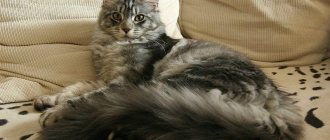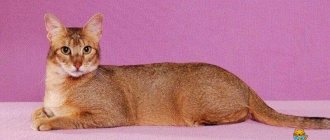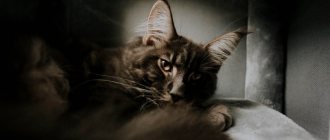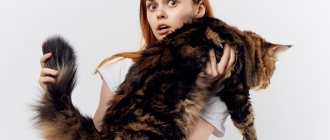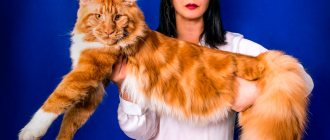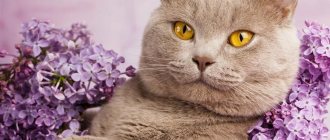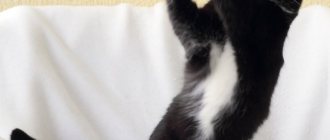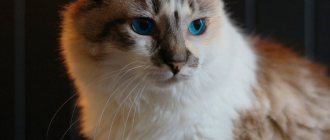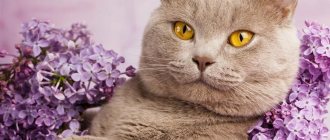Preparing for the arrival of a Maine Coon kitten at home
A novice owner needs to familiarize himself in advance with the features of keeping an elite Maine Coon:
- Allocate space for your pet to relax and play – the entertainment area of a big cat should be spacious.
- It is necessary to take care of products for caring for your pet’s fur; it is necessary to accustom your Maine Coon to combing from the first days of acquaintance.
- Find a secluded place for the toilet tray.
- Buy suitable toys for your cat - little Maine Coons love to run after a wind-up mouse or jump for a wand with feathers.
This is interesting! As a child, the Maine Coon most strongly demonstrates the nature of its freedom-loving ancestors. A representative of this breed instinctively learns to hide, sneak up and suddenly attack, and catch prey, although this skill will not be useful to him in later life.
Features of caring for a Maine Coon kitten
Maine Coon kittens, which are purchased from a nursery at the age of 3 months, already have initial socialization skills, know how to eat and go to the toilet correctly. In this case, the pet's training process is simplified, and the animal's introduction to its new home must be carried out according to the breeder's recommendations.
You cannot suddenly change the rules of behavior of a young cat; its innate instincts will not allow it to quickly adapt.
Caring for Maine Coon kittens involves gradually and unobtrusively introducing them to an unusual environment. The owner must spend a lot of time with the pet and participate in games.
Breed Features
When breeding this type of cat, breeders wondered not only about the external characteristics of the animal, but also about its future character.
By combining the largest breeds of raccoon cats, scientists tried to solve two problems at once: to breed an excellent rat hunter, while maintaining the ability to be an affectionate animal.
Maine Coons had to remain friendly and be able to find contact with their owner.
As a result, it was possible to combine these contradictory traits in one animal. On the one hand, maines are large in size, but at the same time, they are quite active and playful.
Despite their regal appearance, these cats are inherently attached to humans and dependent on them.
Maine Coons are an affectionate and friendly cat breed/Yandex Collections
How and what to feed a Maine Coon cat
A nutritious diet plays an important role in a cat’s development. In order for the kitten to grow up healthy, you need to follow the recommendations of experts regarding feeding the Maine Coon.
During this period, it is necessary to determine the feeding option - leave the cat on regular food or switch it to industrial food. Every decision has positive and negative sides.
The first method will require increased financial costs, taking into account the individual characteristics of the breed in maintenance.
Dry or wet industrial products for feeding the Maine Coon are selected according to the recommendations of the manufacturers and the prescriptions of veterinarians for a specific breed of cat.
Important! Unlike other breeds, the Maine Coon is fully formed only by the age of 3-4 years. Before this period, the cat grows up, and a person needs to take this circumstance into account when organizing the diet of a furry pet.
Interaction with people
Raccoon cats treat people differently. It all depends on who they see in front of them. Subconsciously, the Maines divide people into three classes:
- The owners. These are the most important and dear people to them. Their devotion and dependence knows no bounds. It is believed that in an apartment, pets always try to be close to a person or in his field of vision. Therefore, animals cannot tolerate closed doors. This makes them nervous. But, despite their contact nature, Maine Coons do not like hands. They will not sit on your lap for hours or allow themselves to be stroked for a long time even by their owner. Cats prefer to simply be nearby unobtrusively, lying or sitting near their feet.
- Familiar. Cats are more reserved towards this group of people. They prefer to keep their distance without showing any aggression. However, even a stranger can win over such a cat. All you have to do is let yourself be smelled and say a compliment in a calm voice. The cat will understand that they are friendly towards it.
- Other people. Maines treat this category with indifference, without malice.
Playful Maine Coon kitten/Yandex Collections
Issues of raising and training Maine Coon cats
Observing daily behavior helps a person better understand the animal. This method is used in training - the easiest way is to teach a cat to do exactly what is inherent in its nature.
The habits of the Maine Coon cannot be called exclusively cat-like. Generations of wild ancestors and natural selection have led to the breed being credited with canine “manners.” For example, sometimes Maine Coons are ready to bring slippers or a newspaper to a person, unlike ordinary cats.
In the process of raising a pet, you cannot use force - it will become stubborn and will not obey its owner. And given the height and weight of a big cat, its pranks can be destructive for others.
Important! Raising cats of any breed is best done through play, reinforcing reflexes and actions in it. Even a change in voice intonation can show the animal the owner’s dissatisfaction and change its behavior.
Rules for walking a pet
There are two types of walking - independent and with the owner on a harness. In the first case, the cat goes for a walk and comes home in the evening to sleep. This is what they usually do in a village or country house. Walking on a harness is safer, as the cat is always under control. For the city, this method is more preferable, especially for the kuns, who can simply be stolen. In addition, the animal may encounter stray dogs or get hit by a car.
It is better to walk your pet in quiet green places - parks, squares. There are a number of pros and cons of such walks. The advantages include:
- the animal can show its hunting instincts;
- the sun is good for the animal;
- a cat can sharpen its claws on trees;
Walking the Maine Coon.
Street walking also has significant disadvantages:
- there is a risk of contracting dangerous diseases and infections;
- meeting other animals;
- the cat may get scared of something and run away;
- the cat may eat some dangerous foods (poisoned meat) scattered in the bushes.
Considering that city conditions are not the most comfortable for an animal, it will be much safer in your own apartment. A cat can throw out its energy by playing with its owner or in its play area. After a walk, the animal needs to be bathed, especially since coons like this procedure. Before going on a walk, you should also treat them with flea and tick sprays or wear a special collar.
Cat hygiene
General care for a Maine Coon does not create any trouble for an experienced person. All representatives of this family are distinguished by cleanliness, but the big cat stood out here too. He loves water, swims with pleasure and snorts loudly at the same time - the habits of his wild ancestors are genetically transmitted to the breed through many generations.
Keeping a Maine Coon in a human home necessarily involves toilet problems. Typically, cats of this breed learn quickly and go to the litter box normally. The cause of the failure may be a bad smell or residual waste in the filler.
Items for cat hygiene should be purchased taking into account the size of the animal or, as the cat gets older, replace the small tray with a larger one.
Otherwise, keeping a Maine Coon in an apartment is no different from keeping cats of other breeds in it.
Caring for the ears, eyes and teeth of a Maine Coon cat
In describing the care of a Maine Coon, you need to consider three separate positions: the organs of vision, hearing, and smell.
Assessing the condition of the nasal mirror does not require separate actions. If necessary, the cat's nose is carefully cleaned of crusts and the cause of their formation is determined.
Bathing and trimming Maine Coon's nails
It is not recommended to wash your Maine Coon frequently, although his love of water sometimes makes this prohibition difficult. But when bathing your pet, you need to follow certain rules:
To wash a Maine Coon at home, you will have to stock up not only with patience, but also with time.
Another important procedure is cutting the claws; a kitten should be accustomed to it from childhood. At the tips of the paws in the area of the pads there are many small blood vessels. Therefore, you need to trim the claws carefully so as not to injure your pet.
How to organize Maine Coon coat care
Maine Coons have to be brushed constantly. Like all long-haired cats, the Maine Coon sheds its hair.
Important! The reason that a cat sheds a lot may be due to the age factor. Increased metabolism during adolescence stimulates hair shedding.
Cleaning ears, eyes and nose
The Maine Coon's eyes, ears and nose need to be cleaned regularly as dirt and natural secretions accumulate here.
Mucus accumulates in the corners of the eyes, on which various dirt sticks. If these black spots are not removed, they can cause various eye infections. In this case, you will have to contact a veterinarian. It is much easier to prevent such diseases. You can remove it with a cotton sponge dipped in clean warm water or weakly brewed black tea.
The cat's ears require special attention. They are inspected once a week and cleaned if necessary. Healthy ears should have a pink tint.
If during inspection a buildup of sulfur is detected, it must be removed. There are special solutions for this that can be found in zoological stores.
Practical advice on the care and maintenance of a Maine Coon
Compared to other breeds, keeping a large cat with long hair has a number of differences.
Important! Luxurious fur often gets into the cat's stomach, forms dense balls there and can cause intestinal obstruction. Therefore, it is necessary to regularly give the animal special medications to remove hair from the gastrointestinal tract.
Character
Maine Coons are very peaceful. These cats are able to distinguish between their belongings and those of others, and they do not tend to spoil the owner’s property. They prefer open spaces and large rooms. They do not tend to climb into closets, boxes and mezzanines, as ordinary cats like to do.
Maine Coons themselves try to establish contact with their owner and adapt to his habits and character. You will get the impression that the cat shares your interests, because the Maine Coon will try to repeat your actions. If you spend most of your time in front of a monitor. then he will follow the cursor with curiosity. If you run on a treadmill in the morning, your Maine Coon will join you in doing morning exercises.
Maine Coon vaccination
The first time the procedure is performed on kittens is at the age of 2-3 months. If a young Maine Coon lives with a breeder, the breeder provides veterinary care on his own and hands over the vaccinated pet to the new owners.
If for some reason the vaccination period was missed, the next time it is allowed to be done at the age of 8 months. This is due to the period of teeth change, during which the Maine Coon’s natural immunity is weakened and vaccination can cause unwanted complications.
Important! The specific features of the “street” keeping of Maine Coons (applies to animals that walk outside the apartment) include mandatory regular treatment for external and internal parasites.
Tray training
If a kitten is purchased from a breeder, it means that it is already 2-3 months old, and therefore, it knows what a litter box is.
In this case, the baby only needs to be shown a new place where the kitten should go to the toilet. If, for example, a kitten lives in a large house, it is better to have several such litter trays. Some Maine Coons have a characteristic habit of going to one litter box when needed, and to another when needed.
If litter box training occurs on your own, you need to pay attention to the animal’s behavior. You can recognize that a kitten needs a toilet by its behavior:
- the animal begins to worry;
- looks for a secluded place;
- squeaks or meows.
If this happens, you most likely need to plant it in a tray. The owner must carefully move his pet. If the kitten does not understand what is required of him, the person should dig a little into the filler with his hand, thereby letting the cat understand what needs to be done here. If you were unable to do this in time and the kitten made a puddle, you need to wipe it off with napkins and put them in the tray. By the smell, the kitten will understand where he needs to go.
Tray training.
Maine Coon health and treatment
Proper care of a Maine Coon involves maintaining its natural immunity in order. But there are a number of diseases that are inherent in these cats, especially in old age.
Other pathologies may also appear during life, for example, another important problem is associated with overeating. In a fat Maine Coon, hereditary diseases worsen and immunity decreases.
Care for claws and teeth
If your cat receives dry food, you can brush your teeth once a month.
When receiving soft food, you need to clean it more often - 2-3 times a month. The brush is selected depending on the size of the animal. The animal takes care of its claws on its own, the main thing is that it has a special scratching post. Otherwise, the upholstered furniture or wood in the house will suffer.
Maine Coon and man
In relationships with people, the Maine Coon shows loyalty and sociability. He will try to be a leader and attract attention to himself, but will not impose himself. These cats are not prone to loneliness; they are ready for games and active interaction.
Occasionally they need solitude and contemplation. A duet between a passive person and a Maine Coon is impossible - the animal demands attention and gets offended if its owner ignores it.
Affectionate pet
Kindness and devotion to their owner are the main character traits of cats of this breed. At first glance, it may seem that these are formidable, capricious animals, but your opinion will change if you talk to the cat for a few minutes.
He becomes attached to his owner and is ready to give him his affection and love. But this does not mean that the animal will follow on its heels or you can take the pet on your lap at any time and stroke it; the cat itself will determine when this can be done. However, tenderness and love determine the behavior of the Maine Coon, his communication with the owner, family members and animals.
